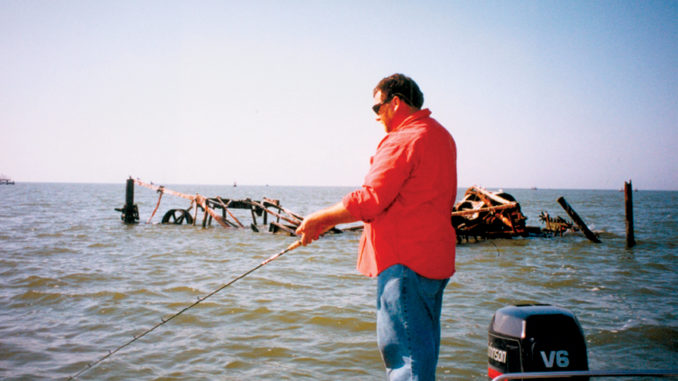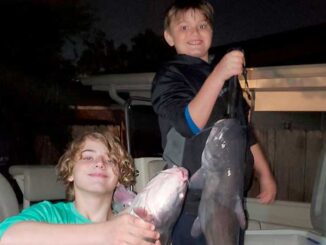
The Black Tanks, the Wreck and the Dope Boat are fading monuments to vivid memories of great fishing.
It’s funny how our memories retain bits and pieces of our past, and how we are able only to remember mere fragments of the days, years and decades gone by.
And it’s strange how certain things can awaken those memories — a smell, for instance, can trigger a gamut of memories of people, places and events, memories long dormant and thought forgotten until that certain smell, that old familiar aroma, opened a long-closed door.
I know there are pictures of past events, people and places, seemingly random, embedded in my mind. I remember my grandfather in his front-porch swing, my aunts and uncles sitting at the table laughing and carrying on in a card game of booray. I remember, as a child, eating cold fried chicken at a picnic table in the Smoky Mountains.
I guess the old observation rings true. We do not remember days; we remember moments. Our minds were simply not programmed to remember entire days, but we do remember bits and pieces of days.
I remember once eating an entire pound cake just before Thanksgiving dinner. I remember I was a 7th-grader riding in a school bus when they announced President Kennedy had been shot. I remember the look on my mother’s face when they told her my dad had died, and the look on my wife’s face when she held our new grandbaby for the first time.
We all hold and cherish similar memories — some good, some painful, some pleasurable.
I talked to a few old friends, picked their brains, prodded their memories, and queried them about their memories of some of the older rigs and structures in Black Bay and Breton Sound — old but familiar structures like the Dope Boat, the Black Tanks, the Wreck. These “Grandfather Rigs,” like all grandfathers, are showing their age, fading before our eyes, and are destined to soon vanish.
I asked them to share their most vivid memories. Here’s what they said.
Lionel Serigne & the Black Tanks
The Black Tanks consisted of a huge black storage tank on legs, and a barge with smaller double tanks mounted on it, surrounded and held in place by pilings.
Located in a field that was developed in the 1950s, it served as a transfer/storage facility whose owners long ago abandoned it, probably due to bankruptcy.
It was battered but left standing by Hurricane Betsy in 1965 and Camille in 1969, but has since lost the double tanks once perched atop the barge, and it has rusted out and sunken almost completely underwater.
But for over five decades it has been one of Black Bay’s best-known hotspots.
Lionel Serigne is one of the real grandfathers of the area. An avid fisherman and owner of Serigne’s Marina in Delacroix (504-684-3502), Serigne recalled one of the most memorable trips of his lifetime at the Black Tanks.
“I used to fish the Black Tanks when they were black, intact, and guaranteed to produce fish,” he said. “The south corner was my favorite spot, and the pilings just off it.
“We fished out there one hot summer day, me and four friends, all on an 18-foot Glassmaster boat, powered by an old Johnson outboard. It was one of those blistering hot days — no wind at all. Extreme heat and humidity, but the fish were hitting our bait as soon as it hit the water. It was incredible; we were reeling in trout after trout, and all beautiful fish.
“That was before they had limits, and we were filling boxes of fish when one of my friends just passed out and collapsed from the heat. He fainted dead away onto the floor, but nobody wanted to stop fishing.
“So we stepped around him for awhile, and then decided maybe we ought to check his pulse. Well, we couldn’t find a pulse, so we figured he must be dead. That being the case, it was no use to hurry back home, so we threw a wet towel over his head and kept fishing.
“After a while, we heard a groan come from under the towel, so we figured he must not be dead after all. But by the time he finally got up, we had all our boxes full, the bite was over, and it was time to head back. It was good that he was alive, but he missed all the good fishing.”
For the past three years, the fishing hasn’t been quite up to par at the Tanks. Maybe the fresh water introduced through the diversion and the higher-than-usual river throughout the spring displaced the hordes of trout that once made the Tanks home. There are still fish there, but not in the numbers that once were.
But who knows? This might be the summer it bounces back.
Brian Epstein & the Wreck
The Wreck actually refers to an old crane that once perched atop a crumbling rig-like structure. We used to fish underneath it, around it, and alongside the huge rig just off to the side of it.
The rig holding the crane eventually collapsed into the bay, leaving only a portion protruding above the surface, but the underwater structure still held fish.
It’s a known hotspot for bull reds and big trout, and while you might not always catch your limit, you’ll usually always find something big to bend your rod.
Capt. Brian Epstein (504-284-3316) has vivid memories of catching his quickest limits ever at the Wreck in the predawn hours of a summer morning. On that day, he left the dock a good while before daylight so the group of young lawyers that chartered him, and their priest friend accompanying them, could begin fishing at the Wreck just as the sun came up.
Fifteen minutes before first light, the fish started biting, and every cast produced a 2- to 3-pound speck.
“By 7:25 (a.m.), we had our 125-fish limit, all beautiful trout,” Epstein said. “And the first person to pop open a beer was the priest, at 7:25 in the morning.”
But most memorable was a trip chartered by Chuck Stewart from Picayune, and a few of his friends.
“We were wailing on the trout, putting some beautiful fish in the box, when I looked over at Chuck, and it seemed like, in slow motion, I saw a fish yank the rod completely out of his hands and pull it overboard.
“I saw his mouth drop, and his eyes pop open wide, and then, almost without thinking, he jumped in after the rod.
“Incredibly, he caught the rod handle, set the hook, and swam back to the boat. He handed me the rod, climbed back aboard, and then landed the fish, which turned out to be the smallest fish of the day.
“The funniest thing was, when he jumped in after the rod, his friends said, ‘There he goes again.’ Turns out, he loses a rod on regular occasions, and jumps in after them.
“Since then, he’s fished with me several more times, and jumped in twice to retrieve a loosely held rod. Once it happened in the dead of winter.
“I nicknamed him the leaping fisherman. He’s a fun guy, and a great fisherman, but don’t loan him your rod.”
Presently, the big rig next to the Wreck is being “P.A.’d” i.e., plugged and abandoned. It is being dismantled and moved.
Soon, only the old rusted remains of the crane that once stood atop the Wreck will protrude above the surface. The underwater remains will continue to attract fish, as will the shell pad around the big rig. But only time will tell if it’ll continue to produce with the consistency it has in the past.
Big Kenny Campo & the Dope Boat
The Dope Boat is a Breton Sound landmark. Well, it was a landmark.
The boat is actually a small ship that was scuttled by drug smugglers after unloading their cargo, and it settled on the bottom in about 14 feet of water.
Even after it sank, much of the boat remained above water, and within a year it was a known fish hotspot. Over time, the mid-section settled, but the bow remained up out of the surface. The old cargo holds in the sub-surface mid-section became a deepwater retreat for big trout, and the savvy angler who anchored in the right spot and was able to toss his live bait over the cargo holds caught fish. Big fish. Plenty of them.
You could also anchor off the stern or bow of the boat and catch fish. It was not uncommon to see eight boats or more anchored around the Dope Boat, especially on weekends.
“It was situated in a good place, not far off the Ship Channel, where it had plenty of good tidal movement,” Kenny Campo (504-676-3679) said. “The water is usually clean out there, and it’s not so close to the Ship Channel to be affected by ship traffic.”
For almost 30 years, the old ship has remained a steady and consistent producer of speckled trout, occasional reds and, at times, Spanish mackerel, jacks, sharks and other species.
The only thing now remaining above the surface is an old mast and a small piece of the bow. The rest has settled or rusted into oblivion.
Unfortunately, less structure in the water means less habitat for the fish, which equates to fewer fish hanging out around the Dope Boat. But the old hulk still produces fish, just not in the quantities it once did.
There are also some very fishable rigs not far from the Dope Boat that anglers gravitate toward when the sunken ship is surrounded by boats or simply not producing.
Campo took Frank Davis to one of those rigs not too long ago to film his Fishin’ Game spot, and a friend tagged along for the ride.
“It was a designer day, perfect in every way,” Campo recalled. “The wind was slight, the weather was cool, the tide was perfect, the water was crystal clear … and the fish were there. They devoured our live croakers.
“And these were the biggest fish I’ve ever caught together like that. I’m not exaggerating, all 5- to 7-pound trout. We put 46 trout in two 120-quart ice chests, and couldn’t close the lids.
“But we had to leave. Frank had to get the cameraman back to the studio to edit film because he had to meet the deadline. But the friend we brought along just couldn’t believe we were leaving. The fish were still biting, and nobody leaves with fish like that still biting.
“He begged me to let him off on the rig. ‘I’ll catch a ride back on a crew boat, I’ll hitch-hike, I’ll swim … just leave me here, please!’
“But I didn’t. And he never forgave me for it.”
These old grandfathers of the sound and bay are still there, but just barely. Time has taken its toll, and they will all soon vanish into oblivion, living on only in the memories of those who once fished there.
Another storm, another season or so, and they’ll be gone. Maybe this is the summer you ought to head out there while they’re still there, and make a few memories of your own.
